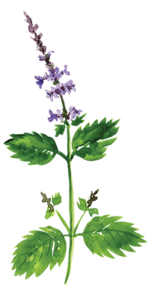 Hindi name: Tulsi
Hindi name: Tulsi
Latin name: Ocimum tenuiflorum
Appearance: A small, aromatic herbaceous annual with fragrant green or purple leaves and purple or white tubular flowers on terminal spikes.
Habitat: Native to India and other tropical areas of Asia; grown extensively in Central and South America; in more temperate regions, holy basil is often grown in pots from seed.
Key constituents: Volatile oil—eugenol; flavonoids—apigenin, luteolin; triterpene—ursolic acid; saponins
Properties: Antispasmotic, analgesic, blood sugar regulator, fever reducer, adaptogenic, anti-inflammatory
Parts used: Aerial parts—leaves and flowers
Practical preparations and uses: Raw form—(ingested) thought to promote overall health, help body adapt to new demands or stress, fight infection; juiced form—as a topical for skin infections, insect bites, ringworm; as an oral rinse for mouth sores; as drops for ear infections; decocted form—taken internally for fever; powdered form—topically applied to mouth sores; tincture form—taken internally for respiratory infections (colds, coughs, bronchitis, pleurisy), fever, to reduce inflammation, to moderate blood sugar, to boost immunity, to promotes overall health.
Source: Chevallier A. Holy basil, tulsi (Hindi). Encyclopedia of Herbal Medicine. New York, NY: DK Publishing; 2016:116.
*Consult with a qualified healthcare professional before attempting to self-treat ailments.





